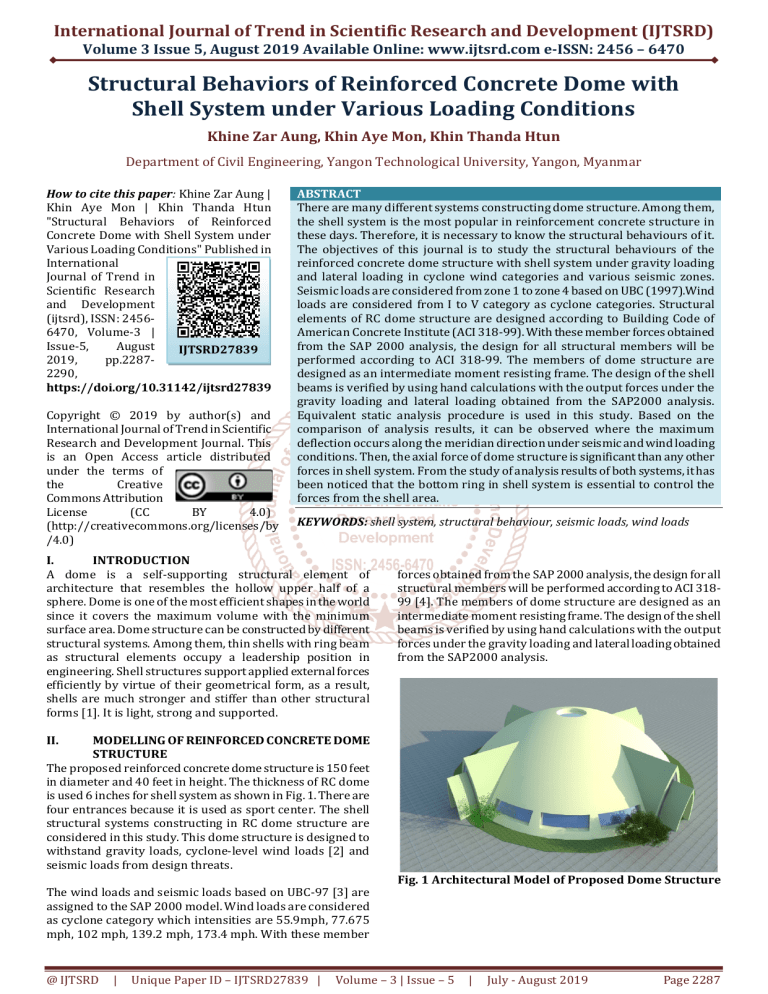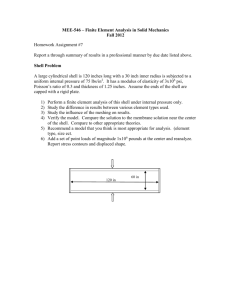
International Journal of Trend in Scientific Research and Development (IJTSRD)
Volume 3 Issue 5, August 2019 Available Online: www.ijtsrd.com e-ISSN: 2456 – 6470
Structural Behaviors of Reinforced Concrete Dome with
Shell System under Various Loading Conditions
Khine Zar Aung, Khin Aye Mon, Khin Thanda Htun
Department of Civil Engineering, Yangon Technological University, Yangon, Myanmar
How to cite this paper: Khine Zar Aung |
Khin Aye Mon | Khin Thanda Htun
"Structural Behaviors of Reinforced
Concrete Dome with Shell System under
Various Loading Conditions" Published in
International
Journal of Trend in
Scientific Research
and Development
(ijtsrd), ISSN: 24566470, Volume-3 |
Issue-5,
August
IJTSRD27839
2019,
pp.22872290,
https://doi.org/10.31142/ijtsrd27839
Copyright © 2019 by author(s) and
International Journal of Trend in Scientific
Research and Development Journal. This
is an Open Access article distributed
under the terms of
the
Creative
Commons Attribution
License
(CC
BY
4.0)
(http://creativecommons.org/licenses/by
/4.0)
ABSTRACT
There are many different systems constructing dome structure. Among them,
the shell system is the most popular in reinforcement concrete structure in
these days. Therefore, it is necessary to know the structural behaviours of it.
The objectives of this journal is to study the structural behaviours of the
reinforced concrete dome structure with shell system under gravity loading
and lateral loading in cyclone wind categories and various seismic zones.
Seismic loads are considered from zone 1 to zone 4 based on UBC (1997).Wind
loads are considered from I to V category as cyclone categories. Structural
elements of RC dome structure are designed according to Building Code of
American Concrete Institute (ACI 318-99). With these member forces obtained
from the SAP 2000 analysis, the design for all structural members will be
performed according to ACI 318-99. The members of dome structure are
designed as an intermediate moment resisting frame. The design of the shell
beams is verified by using hand calculations with the output forces under the
gravity loading and lateral loading obtained from the SAP2000 analysis.
Equivalent static analysis procedure is used in this study. Based on the
comparison of analysis results, it can be observed where the maximum
deflection occurs along the meridian direction under seismic and wind loading
conditions. Then, the axial force of dome structure is significant than any other
forces in shell system. From the study of analysis results of both systems, it has
been noticed that the bottom ring in shell system is essential to control the
forces from the shell area.
KEYWORDS: shell system, structural behaviour, seismic loads, wind loads
I.
INTRODUCTION
A dome is a self-supporting structural element of
architecture that resembles the hollow upper half of a
sphere. Dome is one of the most efficient shapes in the world
since it covers the maximum volume with the minimum
surface area. Dome structure can be constructed by different
structural systems. Among them, thin shells with ring beam
as structural elements occupy a leadership position in
engineering. Shell structures support applied external forces
efficiently by virtue of their geometrical form, as a result,
shells are much stronger and stiffer than other structural
forms [1]. It is light, strong and supported.
forces obtained from the SAP 2000 analysis, the design for all
structural members will be performed according to ACI 31899 [4]. The members of dome structure are designed as an
intermediate moment resisting frame. The design of the shell
beams is verified by using hand calculations with the output
forces under the gravity loading and lateral loading obtained
from the SAP2000 analysis.
II.
MODELLING OF REINFORCED CONCRETE DOME
STRUCTURE
The proposed reinforced concrete dome structure is 150 feet
in diameter and 40 feet in height. The thickness of RC dome
is used 6 inches for shell system as shown in Fig. 1. There are
four entrances because it is used as sport center. The shell
structural systems constructing in RC dome structure are
considered in this study. This dome structure is designed to
withstand gravity loads, cyclone-level wind loads [2] and
seismic loads from design threats.
The wind loads and seismic loads based on UBC-97 [3] are
assigned to the SAP 2000 model. Wind loads are considered
as cyclone category which intensities are 55.9mph, 77.675
mph, 102 mph, 139.2 mph, 173.4 mph. With these member
@ IJTSRD
|
Unique Paper ID – IJTSRD27839 |
Fig. 1 Architectural Model of Proposed Dome Structure
Volume – 3 | Issue – 5
|
July - August 2019
Page 2287
International Journal of Trend in Scientific Research and Development (IJTSRD) @ www.ijtsrd.com eISSN: 2456-6470
A. Material properties
Analysis property data,
Weight per unit volume = 150 pcf
Modulus of elasticity = 3605 ksi
Poisson’s ratio = 0 for shell system [4]
Design property data,
Concrete strength (fc') = 4,000 psi
Reinforced yield stress (fy) = 60,000 psi
Shear reinforcing yield stress (fys) = 60,000 psi Data for
dead load
B. Data for gravity load which are used in structural
analysis are as follows:
Superimposed dead load = 20 psf (Ceiling is considered as
superimposed dead loads)
For dome with 1/8 ≤ rise /span ≤3/8, Roof live load =
minimum 16psf (used 20psf).
C. Data for wind load Data for wind load which are
used in structural analysis are as follow:
Exposure type
=C
Effective height for wind load
= 34 feet
Different wind velocities on model = 55.9mph, 77.675mph,
102mph, 139.2mph, 173.4mph
For slope 2:12 ≤ 4:7.5≤ 9:12,
Windward coefficient Cq= 1.4 for outward due to partially
enclosed structure
Windward coefficient Cq = 0.3 for inward due to partially
enclosed structure
Leeward coefficient
= 1.2
Important factor, Iw
= 1.0
D. Data for earthquake load
Data for earthquake load which are used in structural
analysis are as follow:
Seismic Zone
=1, 2A, 2B, 3 and 4 2B
Zone Factor, Z
= 0.075, 0.15,0.2,0.3 and 0.4
Structural System
= Shell system
Soil Type
= SD
Importance Factor, I
=1
Response Modification Factor, R = 5.5
Seismic Response Coefficient, Ca and Cv are varied according
to the seismic zone and soil profile type.
E. Load Combinations
Design codes applied are ACI 318-99 and UBC-97.There are
26 numbers of load combinations which are accepted in
CQHP (Committee for Quality Control of High-Rise Building
Construction Project).
1.
2.
3.
4.
5.
6.
7.
8.
9.
10.
11.
12.
13.
14.
15.
16.
17.
18.
19.
20.
21.
22.
23.
24.
25.
26.
1.4 DL
1.4 DL + 1.7 LL
1.05 DL+1.275 LL+1.275WX
1.05 DL+1.275 LL-1.275 WX
1.05 DL+1.275 LL+1.275 WY
1.05 DL+1.275 LL-1.275 WY
0.9 DL+1.3WX
0.9 DL-1.3WX
0.9 DL+1.3WY
0.9 DL-1.3WY
0.9 DL+1.02EQX
0.9 DL-1.02EQX
0.9 DL+1.02EQY
0.9 DL-1.02EQY
1.05 DL+1.28LL+EQX
1.05 DL+1.28LL-EQX
1.05 DL+1.28LL+EQY
1.05 DL+1.28LL-EQY
1.16 DL+1.28LL+EQX
1.16 DL+1.28LL-EQX
1.16 DL+1.28LL+EQY
1.16 DL+1.28LL-EQ
0.79 DL+1.02EQX
0.79 DL-1.02EQX
0.79 DL+1.02EQY
0.79DL-1.02EQY
where,
D.L = dead load
L.L = live load
WX = wind load in x direction
WY = wind load in y direction
EQX = earthquake load in x direction
EQY = earthquake load in y direction
III.
SHELL
BEHAVIORS
AND
DESIGN
CONSIDERATIONS
While shell system of RC dome structure is analyzed under
gravity loading and lateral loading, membrane actions are
more effected in any other forces in dome structure. Shell
areas are designed under the membrane forces along the
meridian and circumferential directions. In the design of
shell area for dome structure, the reinforcement is placed
due to F11 along circumferential direction and F22 along the
meridian direction. Shear is checked in designed area. The
shear is under the concrete nominal shear. So, it is no need to
provide shear reinforcement. In design of shell area for RC
dome structure, tensile force can be directly resisted by steel
and compressive force can be resisted by steel and concrete.
Table1. Provided Steel Areas for Each Portion.
Provided Steel area for
Provided Steel area for
circumferential plane
meridian plane per feet
Top portion
No.5 bar @ 6” c/c spacing in
No.5 bar @ 8’’ c/c spacing in
both layer
both layer
Area between openings
No.7 bar @ 6’’ c/c spacing in
No.5 bar @ 6’’ c/c spacing in
both layers
both layers
Entrance dome at upper level
No.7 bar @ 6’’ c/c spacing in
No.7 bar @ 6’’ c/c spacing in
both layers
both layers
Tension ring at plinth level
6no.9 bars
B 24x24
Compression ring at top
3no.5 bars
B10x14
@ IJTSRD
|
Unique Paper ID – IJTSRD27839 |
Volume – 3 | Issue – 5
|
July - August 2019
Page 2288
International Journal of Trend in Scientific Research and Development (IJTSRD) @ www.ijtsrd.com eISSN: 2456-6470
Edge beams stiffen the shell edges and act together with the shell in carrying the load of the supporting system. Beam size 2
24”
x24” is used for the edge beam in plinth level. Edge beams carry the longitudinal tensile force. 6No.9 bars are provided for
maximum tensile force Pmax=308 kips.
IV.
ANALYSIS RESULTS AND DISCUSSIONS
The gravity loading due to dead load and live load and lateral loading due to wind or earthquake are the major factors that
cause different displacements and forces in reinforced concrete dome structure with shell system. There are seven critical
points on this structure depending on structural configuration as shown in Fig. 2.
Fig.2 The Critical Points of the Plan View of Reinforced Concrete Dome Structure with Shell System
EQ COMB ZONE 4
EQ COMB ZONE 3
EQ COMB ZONE 2B
EQ COMB ZONE 2A
EQ COMB ZONE 1
W COMB (175mph)
W COMB (140 mph)
W COMB ( 100 mph)
W COMB ( 80 mph)
W COMB(60 mph)
1.4DL+1.7LL
Displacements (inches)
1.4DL
A. Maximum Displacements in Shell System
Fig. 3 shows the maximum displacement in X, Y and Z directions of point 1 which is in middle portion (2) above window under
twelve critical load combinations. The displacements of X, Y, and Z direction are gradually increased according to the wind
speed and the seismic zone. The maximum displacement at that point in shell system is 0.26 inches in Z direction which is
under wind load combination 4 (1.05DL+1.275LL
(1.05DL+1.275LL-1.275WX).
At point 2, Max displacement
U1 in X direction (inches)
At point 2, Max displacement
0
U2 in Y direction (inches)
-0.05
-0.1
-0.15
At point 2, Max displacement
U3 in Z direction (inches)
-0.2
-0.25
-0.3
Fig.3 Maximum Displacements at the Point of Middle Po
Portion
rtion (2) above Window in Shell System of Dome
B. Maximum Membrane Forces of the Shell Area of Bottom Portion
Membrane Forces
(kips/ft)
Forces along circumferential
direction F11 (kip/ft)
0
-50
Forces along meridian
-100
direction F22 (kip/ft)
-150
-200
-250
Fig. 4 Maximum membrane forces along the circumferential direction F11 and the meridian direction F22 in the
critical area of bottom
The Figure 4 shows maximum membrane forces along the circumferential direction F11 and the meridian direction F22 in the
critical area of bottom portion of RC dome with shell system. In critical wind loading combination, maximum membrane for
forces
along the circumferential direction F11 and the meridian direction F22 in the critical area of bottom portion are gradually
@ IJTSRD
|
Unique Paper ID – IJTSRD27839
27839 |
Volume – 3 | Issue – 5
|
July - August 2019
Page 2289
International Journal of Trend in Scientific Research and Development (IJTSRD) @ www.ijtsrd.com eISSN: 2456-6470
increased according to the wind speed and that of under seismic load combinations are also gradually increased as the seismic
zone is high. The maximum membrane force along the meridian direction F22 in the critical area of bottom portion under
maximum wind loading is more than that under gravity loading and maximum seismic loading combination by 1.12 times and
1.34 times.
250
200
150
100
50
0
-50
-100
-150
At critical bottom ring beam (8) critical
axial force P (kip)
At critical bottom ring beam (8) Critical
shear force v2 (kip)
EQ COMB ZONE
4
EQ COMB ZONE
3
EQ COMB ZONE
2B
EQ COMB ZONE
2A
EQ COMB ZONE
1
W COMB
(175mph)
W COMB (140
mph)
W COMB ( 100
mph)
W COMB ( 80
mph)
W COMB(60
mph)
1.4DL+1.7LL
At critical bottom ring beam (8) Critical
major bending moment M3 (kip-ft)
1.4DL
forces
C. Maximum Forces of Critical Ring Beams in Shell System
Fig. 5 shows the critical axial force, major shear, minor shear, major bending moment, and torsional moment of the critical
bottom ring beam (8) in shell system under twelve critical load combinations. Among them, the axial force and bending
moment are the significant forces under all critical loading. The maximum axial force in the critical bottom ring beam I in shell
system is 200.4 kips which is under wind load combination4 (1.05DL+1.275LL-1.275WX).
At critical bottom ring beam (8) Critical
shear force v3 (kip)
At critical bottom ring beam (8) Critical
torsional moment M3 (kip-ft)
Fig.5 Critical Forces of Critical Bottom Ring Beam (8) in Shell System
Reactions(kips)
D. Critical Reactions of the Shell System
250
200
150
100
50
0
-50
Reaction in X direction F1 (kips)
Reaction in Y direction F2 (kips)
Reaction in Z direction F3 (kips)
Fig.6 Maximum Reactions F1 in X Direction, F2 in Y Direction, and F3 in Z Direction at Critical Point (9) at the Base
of Y Beam in Shell System
Fig. 6 shows the reactions F1 in X direction, F2 in Y direction, and F3 in Z direction at the critical point (9) at the base of Y beam
in shell system under twelve critical load combinations. The reactions of X, Y, and Z direction are gradually increased according
to wind speed and seismic zone. The maximum reactions in shell system is 207 kips in Z direction which is under wind load
combination 4 (1.05DL+1.275LL-1.275WX).
V.
CONCLUSION
From the above study, it can be concluded as the following.
1. From the study of analysis results of shell system in RC
dome, the maximum displacement occurs in Z direction
in the middle portion of dome under wind load
combination.
2. The membrane forces are also the maximum under wind
load combination in both meridian and circumferential
directions.
3. From the analysis result of critical bottom ring beam,
the axial forces are 230 kips in shell system. Therefore,
the bottom ring in shell system of dome structure is
essential to control the forces from the shell area.
4. The critical reaction in Z direction is control any other
reactions in shell system. The maximum reaction in this
system of dome is 207 kips which is also under wind the
combination.
@ IJTSRD
|
Unique Paper ID – IJTSRD27839 |
ACKNOWLEDGEMENTS
The authors are extremely grateful to the teachers from
Department of Civil Engineering in Yangon Technological
University, for their guidance, advice and encourages for
completing this paper.
REFERENCES
[1]. Aduard Ventsel, Theodor Krauthammer. 2001. Thin
Plate and Shell, The Pennsylvania State University,
University Park, Pennsylvania
[2]. National Weather Service (NOAA). No Date. ‘‘SaffirSimpson Hurricane Scale’’, August 2012 < http://
www.ohesp.lousiana.gov/hurricanecategories.htm>
[3]. International Conference of Building Officials. 1997.
Structural Engineering Design Provisions, Uniform
Building Code. Volume 2.
[4]. American Concrete Institute Committee.1999. Building
Code Requirements for Structural Concrete and
Commentary ( ACI318.99 ). U.S.A American Concrete
Institute Committee
Volume – 3 | Issue – 5
|
July - August 2019
Page 2290




